Ceiling speakers: features and varieties
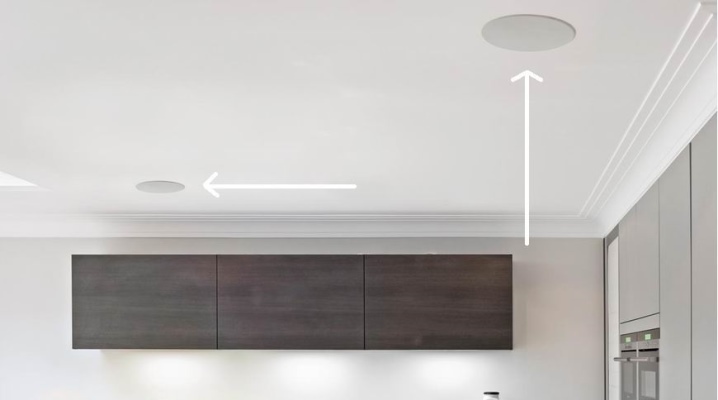
In the modern world, music has become an integral part of each of us, but listening to it with headphones at home is not always convenient, and good acoustic systems take up a lot of space. Therefore, music lovers are often interested in built-in speakers.
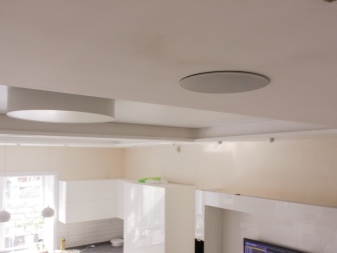
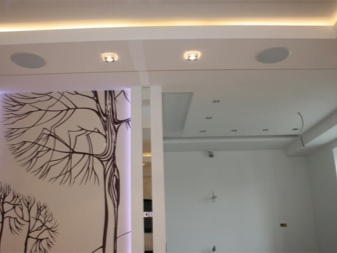
Speakers in the ceiling not only free up floor space, but also keep the room attractive without overwhelming the interior. In addition, on the modern market you can find built-in speaker systems in a wide variety of design solutions, ranging from inconspicuous speakers to audiolyusters.
They are all controlled via Bluetooth.
Despite its compactness compared to floorstanding speakers, ceiling solutions boast pretty good sound... In addition to apartments, such models are often used in educational institutions, shopping centers, subways and other public places.
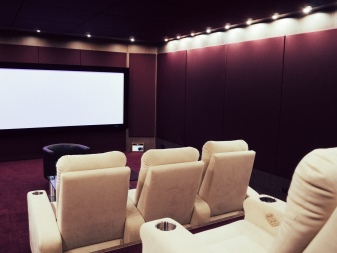

Peculiarities
The following are the key features of the ceiling speakers.
- Thanks to this solution, the sound will spread evenly throughout the room. If we compare ceiling and floor acoustic systems, then the latter, in turn, provides for the need to place additional sound sources. This point is especially important if the speakers are located in large rooms with a large crowd of people.
- Most ceiling recessed products are completely invisible to the eye. A person does not see either the wires or the speakers themselves.
- This solution is lightweight and small., so the owners do not have to worry about the safety of the ceiling.
- If there are small children in the house, then you can be sure that they will definitely not harm the equipment, since it is set too high.
- There are a huge number of models on the market in a variety of shapes and colors., thanks to which even fastidious buyers will be able to choose the acoustics based on their preferences, room design and other factors.
- There are speakers in a moisture-resistant case that can be placed in the bathroom, over an indoor pool and in other areas with a high level of moisture.
- Ease of installation... The owners can fix the speakers in the ceiling on their own without having any installation skills. The fastening process is almost the same as installing spotlights.

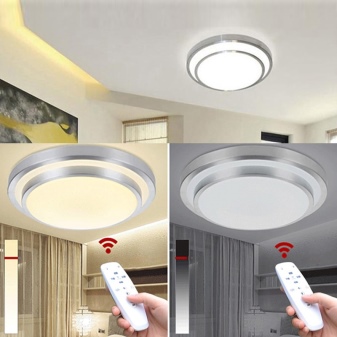
Differences
Despite the fact that all models have a lot in common, such speakers also have differences in some parameters, which will be discussed below.
By form
Similar products are made in the form of a circle, oval and square. However, the most common are round speakers.
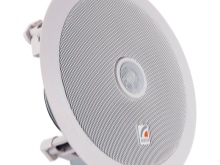
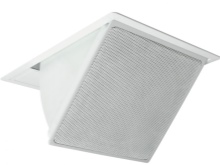
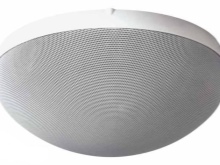
By sound class
According to the sound class, ceiling speaker systems are divided into two types:
- broadcasting;
- low resistance.
Each of them has its own purpose.
Broadcast speakers are most often found in large conference rooms or lecture halls, where the emphasis is on loudness, and the quality of the broadcast does not play a big role. The main component of such an acoustic system is a transformer consisting of windings that split one strong signal into several weak ones. These speakers are equipped with 100 volt transformers, so the quality of the reproduced sound is significantly lost.
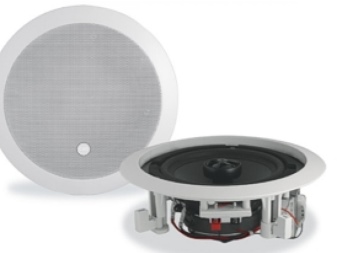
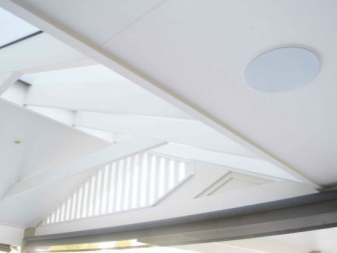
Please note that the translating speakers are connected with small cross-section wires (in parallel). But the total power of all sound sources must not be allowed to be less than the power of the amplifier.
Low-impedance models boast good sound quality. The speakers are connected with a cable with a cross-section of 1.5 mm. If there is a need to install speakers at a distance of more than 30 meters, then experts advise using wires with a cross section of 2.5 mm.
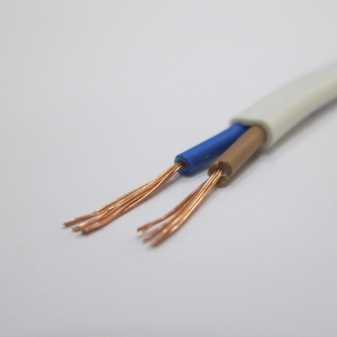

Species overview
Let's take a look at the three main types of ceiling speakers.
Suspended speakers
Products are installed only on a smooth base. They are lightweight speakers with a streamlined chassis, so they will blend in harmoniously with any interior design. Most often they are mounted in false ceilings or false ceilings.
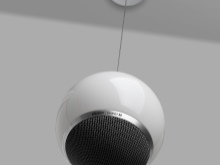
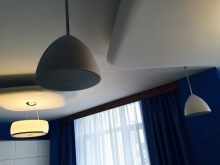

Acoustic chandeliers
If the owners are not satisfied with the above option, and they want a more powerful system, then you can opt for chandeliers. Such solutions are mounted on the ceiling, the speakers are initially installed in the chandelier body. All necessary mountings and installation instructions are included.
The most common are high-tech models.
These speakers are usually located in rooms with high ceilings or in public areas. The big advantage is that these chandeliers can even be installed in domed ceilings.

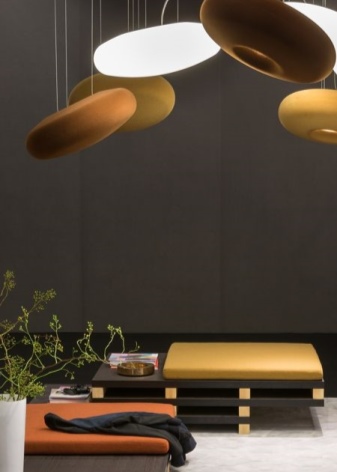
Built-in speakers
Such columns, in turn, are also divided into two groups: open and closed. Closed models are mounted in a special case, and open ones do not provide for the presence of a case and can be discreetly installed in stretch or suspended ceilings.
If the acoustic system is purchased for a bathroom or a room with a pool, then experts recommend opting for products in a waterproof case.
If the owners decide to install open speakers in the apartment, then the room needs to be soundproofed, otherwise the sound will be distorted and resonate.
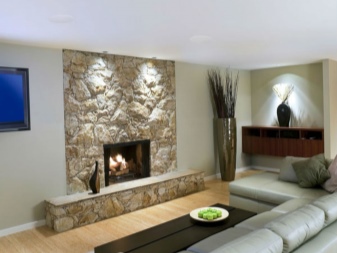
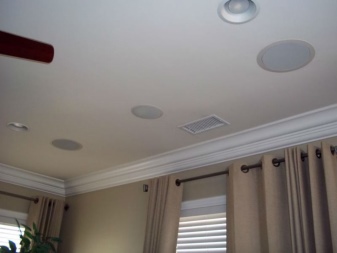
High-end ceiling loudspeakers often have step switches that allow owners to customize the device based on the room's characteristics. The emitter is adjustable, they can be installed at the required angle, and the speaker is covered with a decorative mesh.
Dimensions (edit)
The smallest ceiling speakers are considered to be 4-inch speakers. They fit perfectly into suspended ceilings, the outer part is hidden under a decorative grille, which can be painted in the color of the ceiling. Such products are often installed in bathrooms.

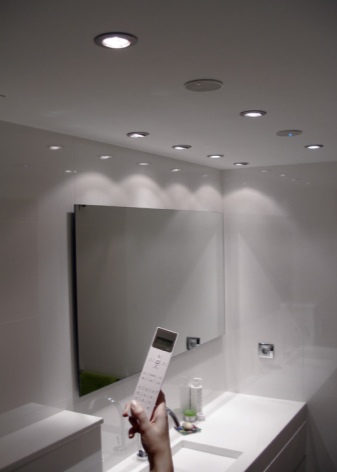
Better sound quality comes from speakers with a diameter of about 6.5 inches. Most models are standard with a white grille, but other shades are available for an additional fee. This acoustics fits perfectly into slats and plasterboard ceilings.
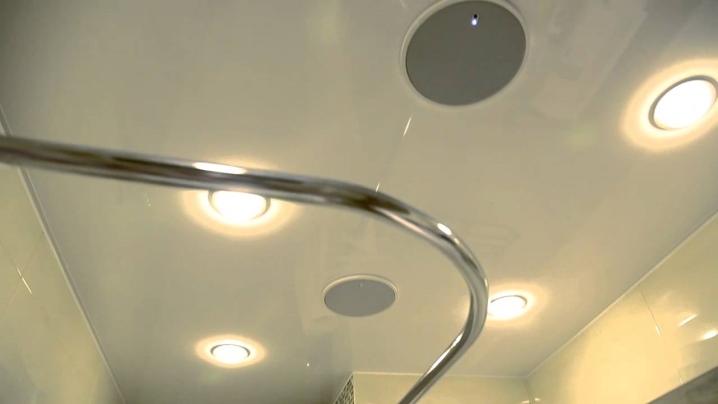
If sound quality is above all for you, then experts recommend choosing 8-inch speakers. Such models are actively used in home theater systems.
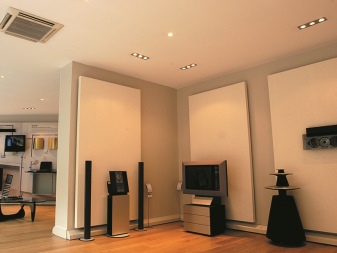
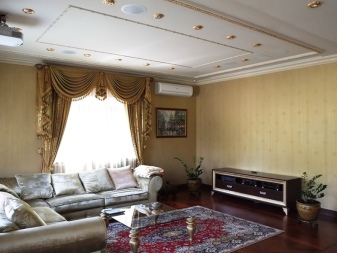
Please note that it is forbidden to install them on a flimsy base.
How to choose?
Consider the following criteria when choosing ceiling speakers.
- Speaker power... If the room is small (up to 17 square meters), then 70 W of power will be enough. If the area of the room is from 25 m, then you will need speakers with a power of 100 watts. In conference rooms, speakers with a power of 150 watts or more are usually installed.
- Interior Design. It is important that the technique fits harmoniously into the overall design of the room. The speaker grill and ceiling must be the same color.
- Indoor air humidity. If the audio system is installed in a kitchen or bathroom, it is better to opt for models in a waterproof case.
- Note that if the ceilings are too high, then low-power devices may not cope with their task.
- Decide for what purpose you need built-in speakers. If you plan to use a home theater system, experts recommend installing an additional speaker on the floor for surround sound.
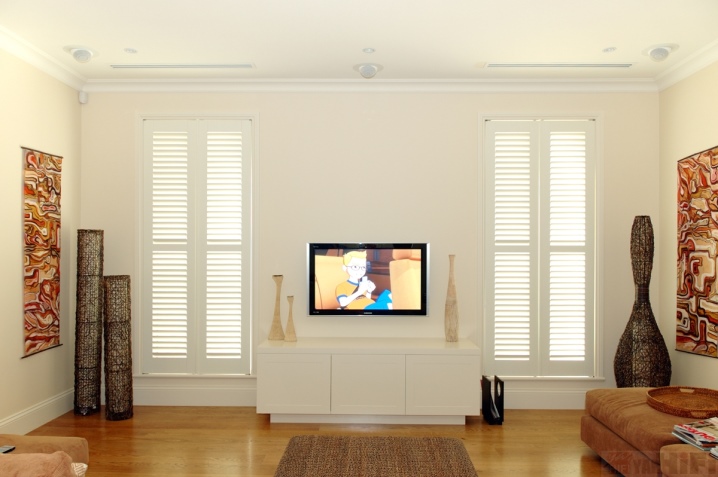
Installation rules
As mentioned earlier, the installation of built-in speakers has a lot in common with the installation of spotlights, but the sequence of work has some differences depending on the type of ceiling.
If you plan to build speakers into a stretch ceiling, then the mounting base should be installed before installing the stretch cover. You can also use plasterboard, plastic or plywood.
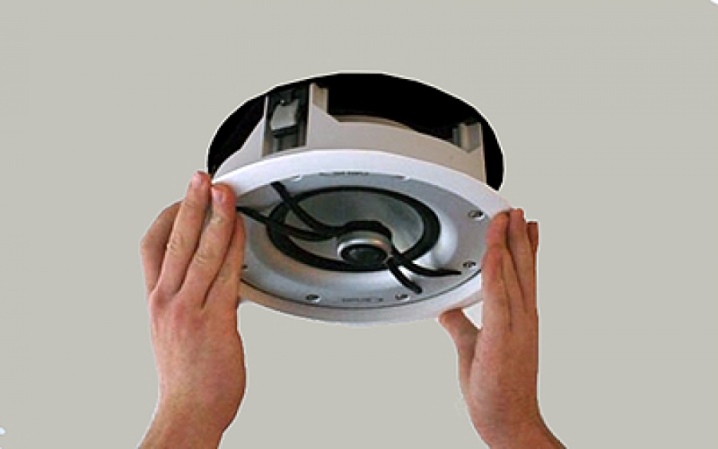
Below, step by step, we will consider the installation of speakers using the example of a stretch ceiling.
- The area of the base should be 2 cm larger than the area of the speaker itself on each of the four sides. The cut is performed so that there are no sharp corners, and the sides are sanded.
- Then using a jigsaw is done hole for installing the column.
- The next step is to attach the resulting base to the base ceiling using suspensions. Please note that the base and the future stretch cover must be at the same level. Be sure to route the speaker wires before installing the PVC tape.
- Next, you can start installing a stretch coating. Carefully feel the base through the canvas and place the thermal ring on this place. It comes in different sizes and is purchased with a speaker system.
- Next, the inner part of the ring must be cut... It is in this hole that the speakers are mounted. They are screwed to the base with self-tapping screws and closed with a decorative grille to match the color of the ceiling.
Installation of acoustics in a plasterboard ceiling is also not difficult.
- After pre-selecting the location of the speakers, all necessary wires should be laid under the base ceiling.
- The next step is to mount the frame. Additional profiles will be required at the place of installation of the speakers.
- Further, through the drywall, the acoustic system itself is installed into the base, and its visible part is covered with decorative grilles to match the color of the ceiling.
Installation of ceiling speakers is discussed in the following video.













The comment was sent successfully.